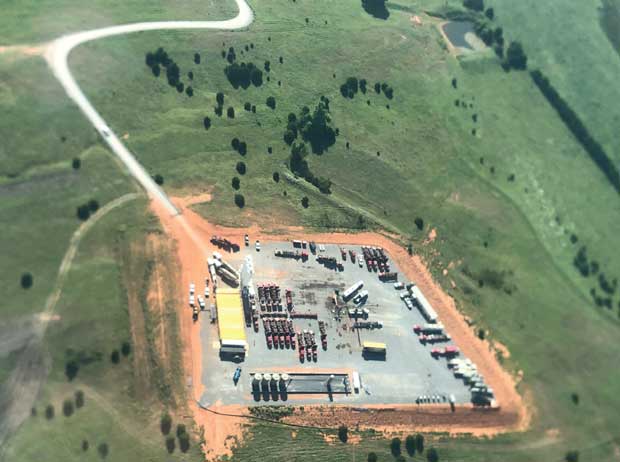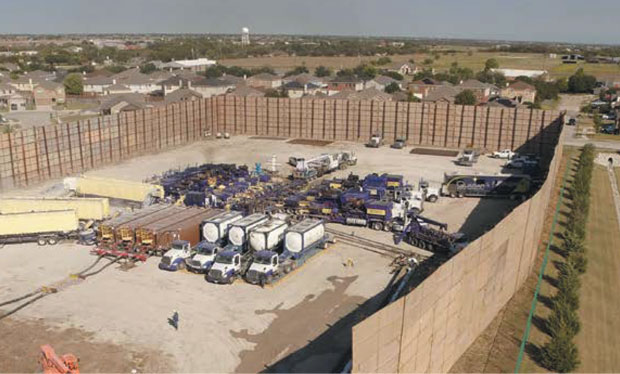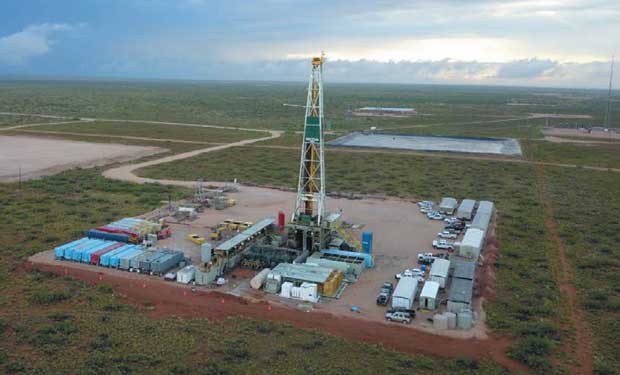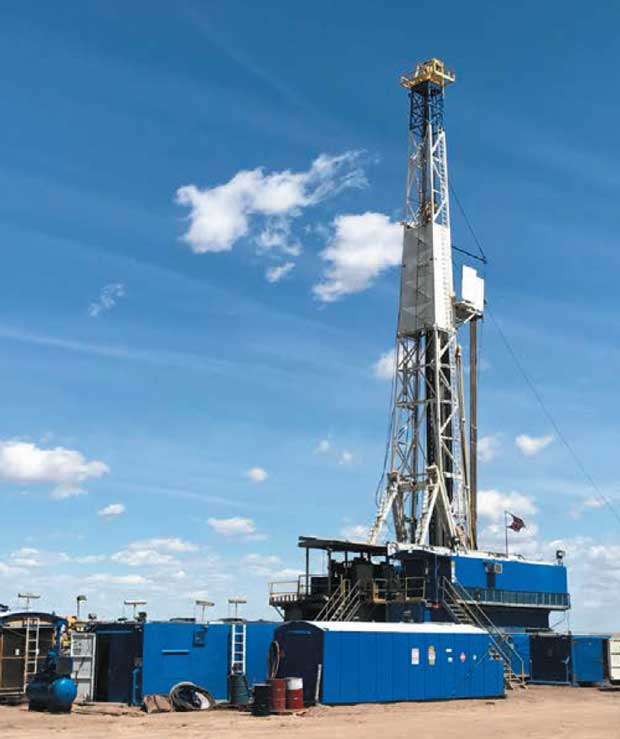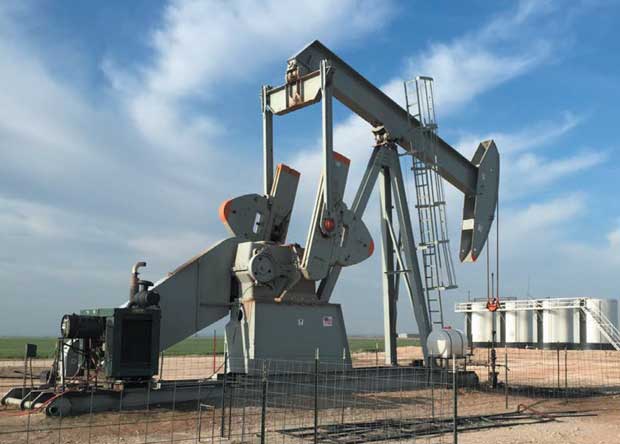
Mid-Continent Operators Firing Up Drilling & Development Action
By Danny Boyd, Special Correspondent
For independent operators of all sizes, the middle is indeed a very good place to be.
From unconventional plays such as the SCOOP and STACK trends in Oklahoma to conventional vertical drilling in Kansas targeting structures delineated by 3-D seismic, the compelling economic payback of deploying technology-based strategies in the Mid-Continent are being augmented by the strongest commodity prices in years. The sunny bottom-line results are amplifying the incentive for operators to fire up new-well drilling and development projects, and re-examine existing inventories of producing assets to look for unrealized upside with refracturing.
As summer approaches, independents are setting their operational sights on targets as diverse as oil-rich Hoxbar/Marchand tight formations in South-Central Oklahoma, liquids-rich natural gas intervals in the STACK in the Anadarko Basin, shallow carbonates yielding mid-gravity crude oil in North-Central Kansas and refracturing gas wells in the Barnett Shale in North Texas.
New Horizontal Target
In Caddo County, Ok., Lynx Oklahoma Operating LLC is developing the Hoxbar/Marchand as a new horizontal target, creating renewed excitement about the potential of multiple tight oil formations that were drilled vertically with variable success by other operators years ago.
Chief Executive Officer Nelson Bolen says the Oklahoma City-based company has a huge advantage over those early vertical development efforts: the ability to leverage drilling and completion techniques perfected in horizontal resource plays along with a better understanding of the subsurface geology.
The first well in Lynx Oklahoma Operating’s Hoxbar/Marchand program, the Captain 6-31-11-12 No. 1 HXL, has produced 225,000 barrels of crude oil in 30 months, Bolen reports.
Lynx Oklahoma Operating LLC is expanding horizontal opportunities in the emerging Hoxbar/Marchand tight oil play in Caddo County, Ok. The first well in the company’s Hoxbar/Marchand program, the Captain 6-31-11-12 No. 1 HXL, has produced 225,000 barrels of crude oil in 30 months.
“We are expanding the horizontal opportunities beyond just pure shale targets to formations often overlooked for horizontal development, and we think Oklahoma provides a lot of opportunity to do that,” he says.
In mid-April, he said Halliburton was stimulating a Lynx Hoxbar/Marchand well and drilling was underway on another. Next up is an offset to the Captain No. 1 HXL well.
Using legacy expertise from geologist and Senior Vice President Al Warner’s 40 years identifying prospects in the area, the company continues to scrub old vertical packages through a tedious approach to mapping 20,000 acres by hand and computer. Lynx’s technical approach differs from other operators in that Lynx splits the target interval into individual sand members and then maps those members across areas with minimal control, expanding the drilling opportunities. The process helps identify separate prospects in thinner sands and determine precise lateral targets, says Matthew Hatami, chief operating officer and engineer.
Lynx’s footprint includes other Hoxbar targets, the Red Fork, the deep Woodford and Meramec shale dry gas targets, which Lynx also is working, but the team’s current attention is on the Hoxbar/Marchand crude oil, Hatami emphasizes.
At a depth of 9,000-10,000 feet, the play varies from less than 10 feet in thickness up to 70 feet, and the company has been able to land laterals in thinner sands without issue, he says.
With inflation, costs per well in April ranged from $5 million to $7 million, Bolen notes, but the company continues to secure pipe and supplies to drill. Lateral lengths have averaged 7,000 feet, although upcoming wells are targeting 10,000 feet.
A different completion approach reinforced by extensive research for the right chemical additives includes 200-foot plug-and-perf stages with 20 clusters and two diversion drops for each stage, Hatami explains.
To open all perforations, Lynx measures instantaneous shut-in pressure (ISIP) at the beginning of each stage. “The brief shutdown to take an ISIP creates a small ‘water hammer’ or momentum change that helps open perforations and enhance injection across the stage,” Hatami comments.
Frac sand volume is limited to 1,500-1,800 pounds per lateral foot, although higher volumes may lead to better production results going forward, he adds. Oil is 40-45 degrees API gravity. Although an initial production rate of 1,000 barrels a day would be possible, Lynx restricts production to 50 barrels per hour initially to avoid flowing back sand and damaging the formation, Hatami says.
After initial decline, production remains relatively flat for an extended period, as demonstrated by the Captain well, he concludes.
Setting New Paradigms
BKV Corporation is setting new paradigms in the Barnett Shale with longer lateral new wells and refracs yielding initial production rates up to 15 times the output gauged just prior to restimulation, says Chief Operating Officer Eric Jacobsen.
The Denver-based company purchased Devon Energy’s Barnett Shale assets in October 2020. The deal included more than 330,000 gross acres and 4,200 producing wells, encompassing an estimated remaining inventory of 400 long-lateral locations and more than 1,200 refrac candidates. Over 200 refracs have been completed to date since BKV assumed operatorship, Jacobsen says.
“The Barnett is alive and well and there is a lot of meat left on this bone,” Jacobsen enthuses. “That point is punctuated by the fact that at BKV, according to Enverus, we completed more refracs in 2021 in U.S. shale plays than any other operator. Refracs alone have kept our 550 MMcf/d gross production base about flat for the past 10 months.”
The company recently has launched a 12-well drilling program. Laterals routinely will be 1.5-2.0 times longer than the historical average of around 5,000 feet, he says, adding that some eventually will be drilled 2.5 times farther. Along with deploying the latest drilling tools to efficiently extend lateral lengths, BKV is leveraging advanced data analytics and modeling to target and place laterals.
BKV Corporation is drilling new Barnett Shale wells with longer lateral and conducting well refracs that are yielding initial production rates up to 15 times the daily rates before restimulation. The company’s Barnett inventory includes an estimated 400 long-lateral locations and more than 1,200 refrac candidates.
On average, new well spacings are 1.5 times wider than legacy horizontals, with modern completion designs tailored for the change, Jacobsen says.
“We have put more consideration into offset depletion and appropriate distance of new wells from that offset,” he details. “We have become laser focused on the right landing zones, optimal well spacing, and are seeking to optimize our costs and execution through lessons learned historically in Barnett wells.”
About 70%-80% of legacy horizontals had completion designs with cluster spacings 200-500 feet apart, Jacobsen says, leaving much of the rock unstimulated as early completion engineers tested various designs. With lessons learned from more than 200 refracs, BKV has devised three different frac designs with more modern cluster spacings to stimulate more rock.
Variations include stimulating the curve in the upper Barnett, and stimulating the heel section partway into the lateral, Jacobsen adds. Refracs have boosted IP rates anywhere from double the pre-refrac rate to up to 15 times the prior daily rate.
Frac design depends on the completion formula, with volumes ranging from 15 to 35 barrels and 800-1,500 pounds of sand per foot, Jacobsen explains. The company is in the process of testing other designs on new wells, he adds.
Operations are reinforced with quality, established infrastructure that includes ample pipelines, midstream capacity, ponds, well pads, roads, and electricity he describes. With refracs and greater volumes, the company has renegotiated with midstream companies on what Jacobsen describes as “win-win rates” for both parties.
“We are building on George Mitchell’s legacy of innovation and continuous improvement and applying all of these to build on a long-life, flat-to-slightly growing asset that provides a low reinvestment rate and stellar economics,” Jacobsen concludes.
Expanded Drilling Program
Drill bit innovations and lessons learned from what works and what does not in regional completion designs are reinforcing Crawley Petroleum Corporation’s 20-well horizontal drilling program this year in western Oklahoma, says Chief Executive Officer Kim Hatfield.
As Crawley celebrates its 50th anniversary, its conservative growth strategy has helped the company weather commodity price cycles and avoid layoffs throughout its history, Hatfield says. While technology and scale have changed, the company’s core philosophy and focus on Oklahoma have remained constant.
That concentration underpins long-term success on a position that includes more than 100,000 acres, 550 operated wells, and 2,000 nonoperated wells across the STACK, SCOOP, Merge and deeper Anadarko. Assets include some of the oldest and now some of the newest wells in Oklahoma, he says.
As it celebrates its 50th anniversary, Crawley Petroleum Corporation is implementing an expanded drilling program, including kicking off a 20-well horizontal program this year in western Oklahoma. Crawley’s portfolio includes more than 100,000 acres, 550 operated wells and 2,000 nonoperated wells across the STACK, SCOOP, Merge and deeper Anadarko.
Beginning in 1972, founder Jim Crawley and his team built the company through the drill bit and acquisitions, Hatfield says. Transitions included a focus on infill drilling in the late 1990s and 2000s that has evolved into horizontal drilling principally across the STACK play, developing mostly gas dominated targets, he details.
A methodical approach to technological assessment and application is a natural outgrowth of Crawley’s deliberate, well-planned approach, Hatfield adds.
“We have seen a lot of incremental improvement in the region, and we pay close attention to what the other operators are doing, learn from their successes and hopefully avoid duplicating mistakes,” he comments.
Drill bit innovation has been a key to improved efficiencies, especially when boring through formations rife with chert that can damage PDC cutters, says Operations Manager Dave Roddy.
Crawley has two rigs drilling since last fall, including one boring one-mile laterals and the other two-mile laterals, alternating between play areas to minimize risk, says President Jason Garner.
Aiding completion designs are efficiencies gained from analysis of downspacing results and job size from other operators as western Oklahoma best practices have moved away from ever more laterals per section and ever-higher proppant loads when sand prices were lower pre-COVID, Roddy says.
Frac stages for Crawley are about 200 feet. Currently, single-section laterals are completed with 5 million-6 million pounds of sand, made up of 1 million pounds of 100-mesh and the remainder 40-70. The process starts with an acid breakdown and cleanup slug of 100-mesh before switching to slickwater and 40-70 sand, Roddy explains.
Recent IPs include 300-400 barrels of oil a day from a Red Fork test and 1.5 -2 MMcf of gas and 100-150 bbl/d of oil from a one-mile Meramec lateral, Garner reports.
The company continually weighs expansion opportunities, although regional properties on the market aren’t cheap these days, Hatfield points out. Capital constrained companies now show far more interest in drilling operated positions and less in partnering through non-ops.
“Our average working interest is running in excess of 75% now, which is very different from what it was in the past,” Hatfield says.
Guided By Seismic
With extensive 3-D seismic and in-depth interpretation supporting an aggressive drilling program, Palomino Petroleum Inc. has grown oil production by more than 65% in six months, tapping chiefly the Mississippian across West-Central and Northwest Kansas, says company President Klee Watchous.
Palomino Petroleum is one of Kansas’ most active drillers, primarily targeting the Mississippian in West-Central and Northwest Kansas. Extensive 3-D seismic interpretation across a lease position that includes 33,000 acres held by production and 80,000 undeveloped acres has helped Palomino identify prospects in Ness and nearby counties, where the company has drilled 30 vertical wells in recent months and plans at least 50 more as it continues to grow oil production.
Data on a position that includes 33,000 acres held by production and 80,000 undeveloped acres has helped identify vertical prospects in Ness and nearby counties, where the company has drilled 30 vertical wells in recent months and plans at least 50 more to go with their current 202 total producers, Watchous says.
“We are among the more active drillers in Kansas and we want to continue to aggressively drill as we have many well sites identified for drilling based on our 3-D seismic and geological information,” he remarks.
Additional pay zones include the Lansing, Kansas City, Marmaton and Cherokee Sand. Inflation has driven up well costs, from around $300,000 to $400,000 or more, but the need for little post-drill stimulation helps hold completion costs in check, Watchous explains.
“There are some very specific instances in which we may utilize a frac, but the for the most part, we have natural completions or complete with acid,” he says.
Detailed data recently influenced the company to keep drilling on a lease in northwest Ness County after two dry holes. The result? A well now on pump producing 90 bbl/d. Production over its lifespan could exceed 100,000 barrels.
“I credit our geologic and geophysical staff for that and for not giving up,” Watchous avers. “Perseverance is key in many of these areas, and I think that’s a good example of it.”
Company oil production is now more than 2,000 bbl/d, up from 1,200-1,300 bbl/d only six months ago, he points out. Palomino continues to search mostly for oil, a strategy undertaken by R.W. Watchous when he founded the company in 1969 and which continued after grandson Klee, raised by his grandfather and taught the oil and gas ropes early in life, assumed leadership at age 19 after R.W.’s passing in 1993.
“Natural gas prices at 13-year highs are good for companies with gas and who had a lot of tough years, but we continue to focus on oil,” Watchous says.
The Newton, Ks.-based company maintains a consistent workover program, where it will utilize standard acid jobs. Palomino also is expanding outside its traditional operating base, he points out. The company recently completed a well in the Illinois Basin and has another scheduled for fall.
Conventional Oil Focus
In Central and western Kansas and northern Oklahoma, Trans Pacific Oil Corporation continues to execute a program of consistent growth through acquisitions and low-cost conventional drilling and completion on an oil-weighted position with 800 producing wells, says President Alan Banta.
This year, Trans Pacific is drilling up to eight wells in Kansas and more in Woods and Alfalfa counties in Oklahoma.
“Our drilling projects are smaller and our economics are tighter, so we try to do everything we can to get the most efficient completions and the most reserves out of the ground,” Banta explains. “We are privately owned and not trying to create headlines, but work to get a good return on our investment.”
Trans Pacific Oil Corporation is drilling up to eight wells in Kansas this year, where targets include the Pennsylvanian, Lansing, Mississippian and Ordovician Arbuckle. In June, Trans Pacific also plans to begin drilling three new vertical wells on a position in northern Oklahoma prospective for oil-bearing Mizner, Wilcox, Viola and the Mississippian limestone.
Founded in Wichita, Ks., in 1980, Trans Pacific focuses primarily on prospects in Rooks, Ellis and Logan counties, Ks., with additional work in the state’s Trego and Stevens counties, he says. Targets include the Pennsylvanian, Lansing, Mississippian and Ordovician Arbuckle, with well depths ranging from 3,500-4,500 feet in North Central Kansas to 4,000-4,500 in the northwest part of the state.
Since target rock consists mostly of carbonates, completions are seldom done with fracs but with acid and additives if any fluid is needed at all, he says. North Central Kansas IPs can average 30-50 bbl/d of oil, with strong wells producing 50-75 bbl/d. Desired reserve targets are above 50,000 barrels.
“These are shallow formations and not overpressured,” Banta explains. “If you can make 75 bbl/d and your completed well cost is $350,000, that works.”
In June, the company plans to begin drilling three new vertical wells on a position purchased in 2014 in Oklahoma’s Woods and Alfalfa counties. With 60 producers, the acreage is prospective mainly for oil-bearing Mizner, Wilcox and Viola, and the 50-50 Mississippian limestone, he says.
The company stimulates the cherty Mississippian with the use of diverters. Frac designs vary based on the nature of the rock in any given area, Banta explains.
“We have tried to take what has been learned from the horizontal guys and pivot that to our much smaller vertical frac situations,” he says.
With workovers including acid jobs, chemical treatments and hot oil, the company continues to work to enhance production and open other zones up hole, Banta adds.
“Kansas and the northern Mid-Continent in general is a low-cost area, and we don’t drill horizontally or have assets in shale plays that need large fracs,” he explains. “We are pretty old school and traditional and lifting costs are relatively low.”
For other great articles about exploration, drilling, completions and production, subscribe to The American Oil & Gas Reporter and bookmark www.aogr.com.







